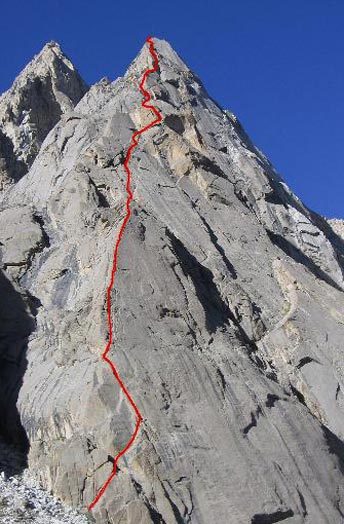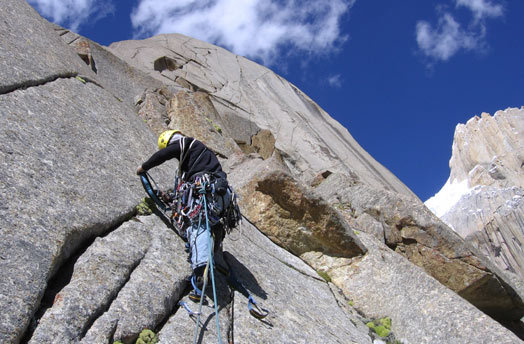
A view of Estrella de la Manana (aka Morning Star, VI 5.10b A1, 17 pitches, 936m of climbing), Pakistan Karakoram. Luis Carlos Garcia Ayala and Ali Muhammad’s first seven pitches (most of the line visible in this photo) follow an almost identical line to the Sadu route (5.11b, 300m of climbing, Antoine and Sandrine de Choudens, 2003); however, Garcia Ayala and Muhammad continued onto the huge granite face above Sadu peak to add more than 600 meters of climbing on what they call La Reina Roja (aka Red Queen). [Photo] Luis Carlos Garcia Ayala
From July 19-22 a Mexican climber, Luis Carlos Garcia Ayala, and Pakistani cook and guide, Ali Muhammad, opened a route on La Reina Roja (aka The Red Queen), the southwest-facing wall above Sadu Peak (4400m), in the Trango Range, Pakistan Karakoram. Garcia Ayala and Muhammad climbed Estrella de la Manana (aka Morning Star, VI 5.10b A1, 17 pitches, 936m of climbing) from the basecamp of Nameless Tower. Though the pair was unaware of overlap at the time of the climb, the majority of their first seven pitches followed the namesake Sadu route (5.11b, 300m of climbing, Antoine and Sandrine de Choudens, 2003; see the October 26, 2006 Newswire) to the summit of Sadu peak. Their final ten pitches above Sadu comprised the bulk of the team’s route and created over 600 meters of new terrain.
For Garcia Ayala, the ascent of Estrella de la Manana signaled a triumphant return to the Trango Group after an unsuccessful attempt on the Slovenian Route (VI 5.11 A0, 900m, Cankar-Knez-Srot, 1987 [FFA: VI 5.12, Albert-Gullich-Munchenbach, 1988]) of Nameless Tower (aka Trango Tower, [6239m]; see Issue 11’s Mountain Profile) in 2000. And, for Garcia Ayala’s climbing partner, Muhammad, the ascent of La Reina Roja marked his first big wall climb.
On July 18, following the left skyline of the southwest wall, Garcia Ayala and Muhammad fixed two pitches slightly right of Sadu to reach the line set by the de Choudens team; they then returned to the ground, forced down by poor weather that would restrict the their progress over the next three days. On their first day of climbing, Garcia Ayala and Muhammad ascended five pitches to a large belay ledge, where they bivouacked. On July 20 they climbed five more pitches but were forced to rappel two pitches–which they fixed–to set up a decent bivy, presumably above the summit of Sadu. On July 21 Garcia Ayala and Muhammad began what they assumed would be a four-pitch ascent to the summit. “We thought it was going to be only four more pitches [above our high point], but, in the end, it was seven pitches, and we reached the top at sunset, 7 p.m.” Garcia Ayala said. “We also forgot head lamps, and the rope stuck on three pitches (15, 14 and 11). The descent was very epic.” The team returned to Pitch 8 and their second bivouac at 1 a.m. on the 22nd, spending the remainder of the day descending the same route.
Garcia Ayala and Muhammad’s opening of Estrella de la Manana not only marks the first ascent of La Reina Roja, the wall above Sadu Peak, but also signals firsts for both climbers. Garcia Ayala, Armando Dattoli and Mario Onate’s expedition to Nameless Tower in 2000 was cut short by a lack of time and poor weather. It took Garcia Ayala seven years to return to the Trangos, with this recent climb as part of a project to open a new big wall route on each continent.
Estrella de la Manana also marks Muhammad’s first big wall climb. In need of a guide and partner, Garcia Ayala invited Muhammad, his Pakistani guide and cook from the 2000 expedition, to join him in his attempt on La Reina Roja. “He was very interested in this project, and wanted to learn big wall climbing techniques,” Garcia Ayala said. “I taught him the basic use of gear, some maneuvers and, when we got on the wall, saw a positive response through his climbing.”
Garcia Ayala considers the new climb an unusually long, big wall option just feet from Nameless basecamp: “It is a 936-meter-long trad climb on excellent granite with good gear placements.” He recommends the nearly all-free climb (a few isolated knife blade placements gave passage via aid), as most pitches have good belays. Furthermore, for an ambitious party, Garcia Ayala said the route “could be repeated, potentially, in a long day… It, absolutely, is a beautiful climbing line.”

Fiddling with gear on the first ascent of Estrella de la Manana, an extension to the Sadu route, Pakistan Karakoram. The climb was Ali Muhammad’s first big wall experience. “I taught [Muhammad] the basic use of gear, some maneuvers and, when we got on the wall, saw a positive response through his climbing,” Garcia Ayala said. [Photo] Luis Carlos Garcia Ayala collection